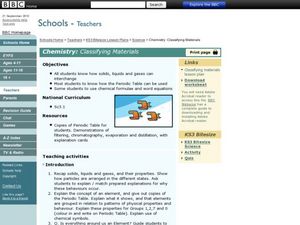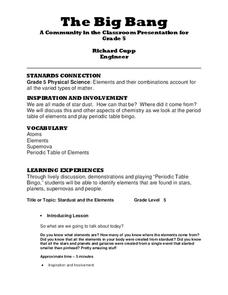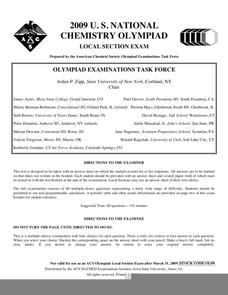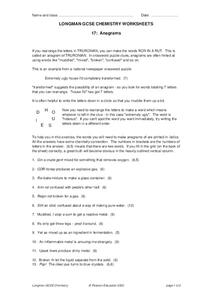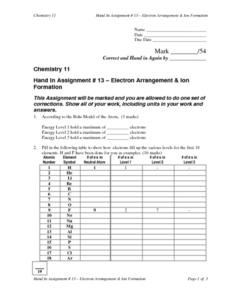Curated OER
Periodic Table Lesson Plan
Students describe how elements are arranged on the periodic table. They compare metals, nonmetals, and metalloids based on their properties and on their locations in the periodic table. Students describe the differences between a...
Curated OER
Chemistry Worksheet 6
In this chemistry worksheet, students calculate specific changes that take place with different chemical reactions. Students indicate whether the reactions are endothermic or exothermic and spontaneous or nonspontaneous.
Curated OER
Chocolatium
Students find the average atomic mass of M & M's. In this chemistry lesson, students are given a sample of the element chocolatium and the atomic mass of each sample. They then find the average atomic mass.
Curated OER
Chemistry: Classifying Materials
Students classify materials. In this chemistry lesson, students examine the properties of solids, liquids, and gases. Students discover the elements, compounds, and chemical symbols.
T. Trimpe
Atomic Basics
Get down to basics with these worksheets on the structure of atoms. Challenging young chemists to identify information from the periodic table and create Bohr diagrams and Lewis dot structures for different elements, this resource would...
Curated OER
Chemistry - Science 10
In this chemistry science worksheet, students identify the parts of a chemical reactions. Kids name the major particles of the atom. Students apply knowledge about the atom, theories, and models.
Curated OER
Review for Chemistry
In this review for chemistry learning exercise, students decide if given statements are true or false. Students relate information learned about introductory knowledge gained in chemistry to accurately answer the given questions.
Science Geek
Element Classes
Introduce your young chemists to alkali metals, alkali earth metals, transition metals, metalloids, nonmetals, halogens, and noble gasses with a presentation that explains the classes of elements and a few facts about each.
Curated OER
The Big Bang
Fifth graders relate the elements in the human body to those produced during a supernova. In this space science and chemistry lesson, 5th graders listen to a lecture and view visuals about the big bang. They relate the production of...
Curated OER
1999 U.S. National Chemistry Olympiad Part III
In this chemistry olympiad laboratory worksheet, learners design and carry out two experiments. They design one experiment to test for the percent mass of a substance in a solution and they design another experiment to identify two...
Curated OER
2000 U.S. National Chemistry Olympiad Local Section Exam
This 60-question comprehensive exam was designed to determine who would go on to compete in the 2000 US National Chemistry Olympiad. Hopefuls answer multiple choice questions regarding all chemistry topics taught in the first year...
Curated OER
2007 U.S. National Chemistry Olympiad Local Section Exam
Sixty multiple choice questions cover the entire gamut of chemistry concepts. This is the local section of the U.S. National Chemistry Olympiad, where your chemistry candidates take a shot at entering the national competition. They...
Curated OER
2004 U.S. National Chemistry Olympiad - Local Section Exam
In this National Olympiad exam worksheet, chemistry apprentices answer sixty multiple choice questions including general chemistry topics such as atomic structure, gases, problem solving, writing and balancing equations and solutions....
Curated OER
2009 U. S. National Chemistry Olympiad - Local Section Exam
Here is a copy of a past national challenge exam that you can use in your general chemistry course as a unit or semester review. Sixty multiple-choice questions query learners on properties of matter, stoichiometry, reactions, and...
Curated OER
Lesson Plan with Technology - Introduction to Elements and Symbols
Middle schoolers use a computer program to study elements and the periodic table. They follow the directions on the computer program, and answer the questions presented. The program is self scoring, and students may print a certificate...
Curated OER
Element Trading Cards
In this chemistry worksheet, students use the Internet to research the elements in the Periodic Table to locate the number of proton, neutrons, and electrons. They also draw pictures that illustrate one or more uses for their elements.
Curated OER
Elements
Students explore the periodic table. In this Chemistry lesson plan, students will review how Mendeleyev predicted the missing elements in the periodic table. The students will then be assigned one of the missing elements to research...
Curated OER
Mass, Mole, Volume Conversions
In this conversion worksheet, pupils make the following conversions, showing each step. Students use the periodic table and express all molar masses to 1 decimal place.
Curated OER
Anagrams
In this chemistry worksheet, students complete a crossword puzzle by rearranging 13 anagrams about elements. They create their own anagrams from 3 given words.
Curated OER
Periodic Table Stack Word Search Puzzle
In this science worksheet, students look for the words that are related to the theme of the worksheet. They also work on the skills of spelling and word recognition.
University of Georgia
Resumé of an Element
Class members use the provided worksheet to create a resume for one element from the periodic table. The activity teaches learners about all of the properties of elements and how to read the periodic table.
Curated OER
Group 1 Alkali Metals
In this periodic table worksheet, students identify the different properties of group 1 elements in order to match the given words with the appropriate question.
Curated OER
Electron Arrangement and Ion Formation
In this elements worksheet, learners determine how electrons fill up the energy levels for the first 18 elements of the periodic table. Students determine if elements gain or lose electrons to form a stable ion. This worksheet has 4...
Curated OER
Atomic Structure
In this atomic structure worksheet, students use the periodic table to complete a chart for 11 elements/ions in terms of atomic number, number of protons, neutrons and electrons.





